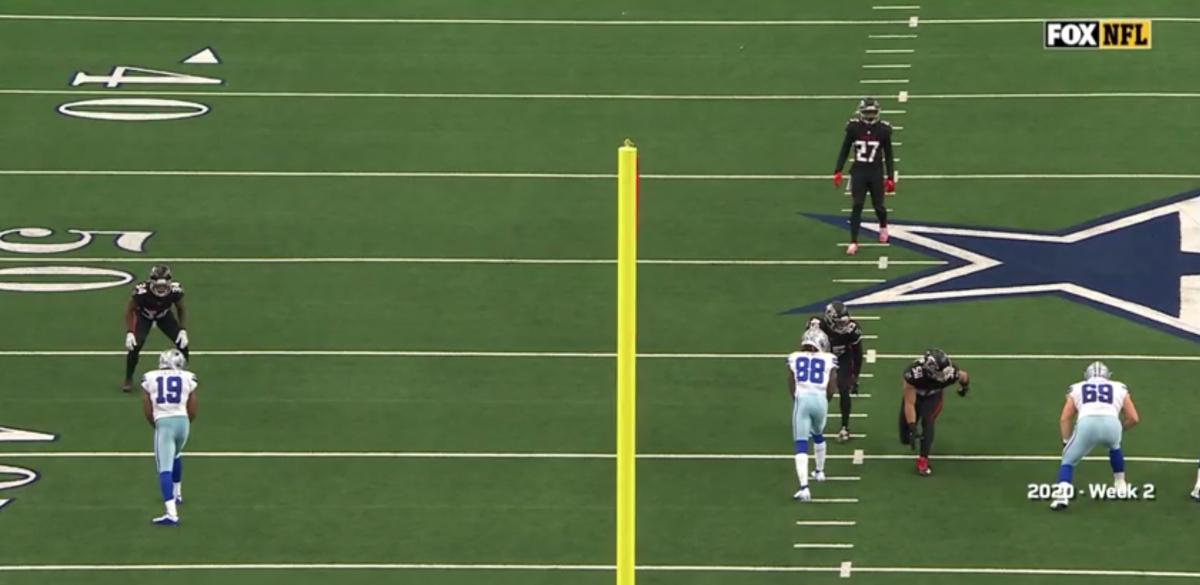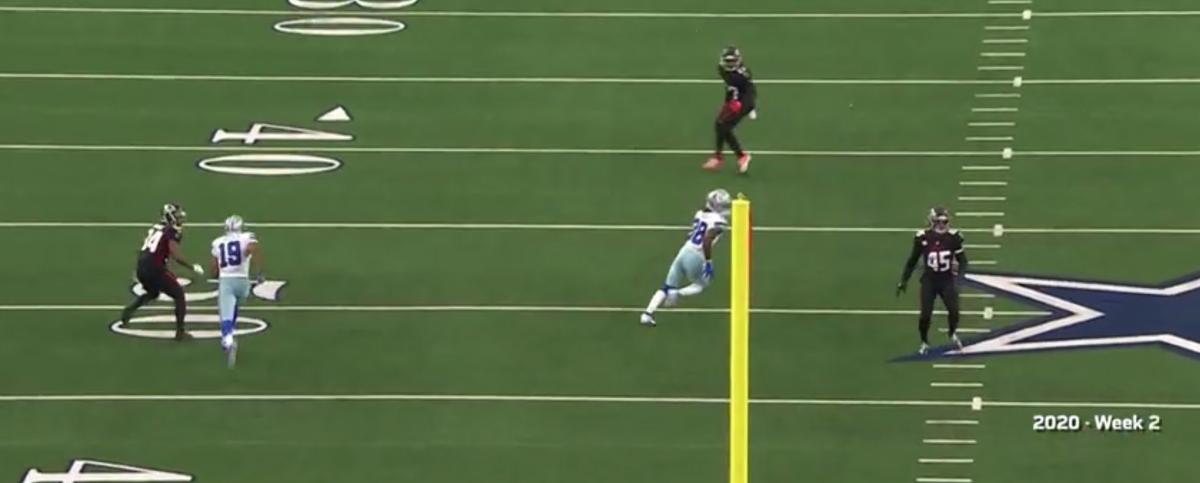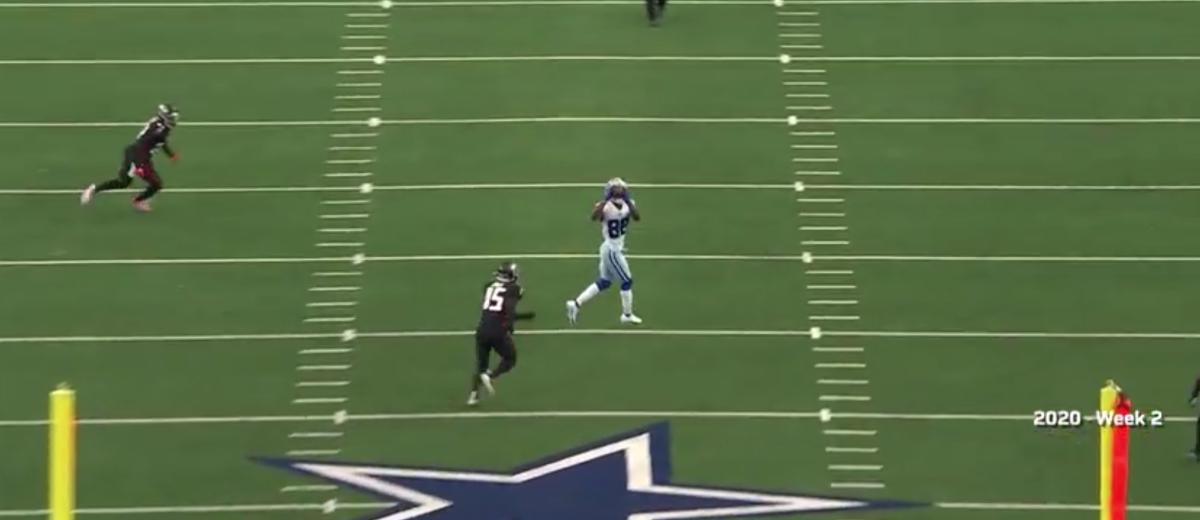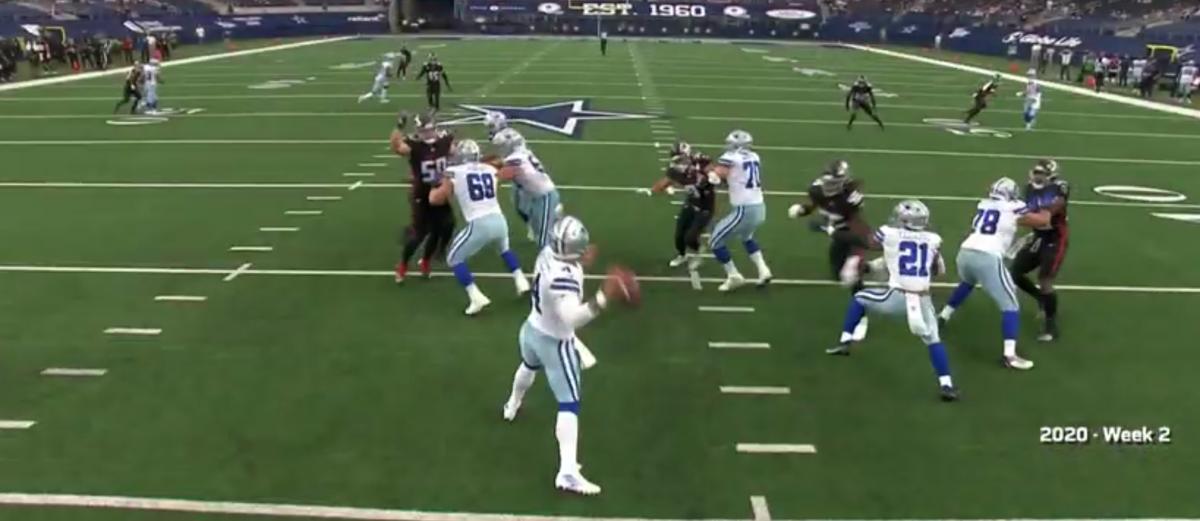Cowboys Rookie Review: The Dak & CeeDee Connection
Dallas Cowboys rookie wide receiver CeeDee Lamb had his first career 100-yard receiving game last Sunday in the Cowboys’ epic 40-39 comeback against the Atlanta Falcons. Today we break down his longest catch of the game, which also turned out to be one of the biggest of the game. ... and evidence of the trust QB Dak Prescott has in the prized newcomer.
"My game is getting better, but it's definitely not where I want it,'' Lamb said this week. "I'm still looking to get better every game, every practice. I'm just looking to keep it going."
It "got going'' late last Sunday.
READ MORE: Inside The Cowboys 'Watermelon' Kick
With the Cowboys down 29-10 at the start of the third quarter, Dallas started with the football. A touchdown would have cut the Falcons’ lead to 12 points and given the Cowboys more momentum. In this situation, the Cowboys faced 3rd-and-6, so the Cowboys needed a catch long enough to move the chains. Lamb gave them much more than that. It was a combination of good play design, audible recognition by both Lamb and quarterback Dak Prescott, along with extremely soft coverage by the Falcons’ defense.
Filing my Cowboys Rookie Review tonight and we will be breaking down this catch by WR CeeDee Lamb. #CowboysNation @CowboyMaven pic.twitter.com/8fAOOaLsMB
— Matthew Postins (@PostinsPostcard) September 24, 2020
The play scheme looked similar to the play the Cowboys had called on first down of this series, which resulted in an incompletion to Amari Cooper. In this case, the Cowboys flipped the formation, overloading to the left of Prescott with three receivers — Lamb in the deep slot, Cooper in the middle slot and Michael Gallup on the edge. Tight end Dalton Schultz was in the left-hand slot and running back Ezekiel Elliott was to the right of Prescott.
The Falcons were also in a similar defensive formation, using six defensive backs. The catch here was that the Falcons left the deep middle open. When the ball was snapped the Falcons had 10 players on the line of scrimmage and just one safety about 10 yards off the line of scrimmage on the strong-side hash. We don’t know at this point if the Falcons are going to play press coverage or soft coverage. It looks like a press scheme. But Prescott recognizes the opening across the middle and audibles. He also knows he has little to lose as the Falcons jump offsides before the snap. He recognizes this. But he needs his rookie receiver to understand it, too.

At this point Prescott has options, and the play is designed to give him that. It could be Schultz on a rub route. It could be Cooper using Lamb as a natural pick and coming in on a quick slant. Lamb could step to his left and cut right back inside. Elliott could come out of the backfield. The key for Prescott and for Lamb is how the defender right in front of Lamb, linebacker Deion Jones, plays Lamb.
This is where the Falcons made their mistake, scheme-wise. While Jones (6-foot-1, 227 pounds) has the quickness to cover, this is still a mismatch in Lamb’s favor due to Lamb’s speed and the deep safety position. In this situation Jones is better off hitting Lamb as he comes off the line of scrimmage and taking him out of the route. If Jones had done this, Lamb likely would not have been the receiver targeted on this play. But instead, as the ball is snapped, Jones basically does nothing more than backpedals and makes a tepid effort to keep Lamb from cutting inside right away. That much he prevents. But he prevents little else and I’m not sure Lamb wasn’t setting Jones up for something bigger anyway. Jones’ passive coverage allows it to happen.
Offensive coordinators like to flood sides of the field with multiple receivers for different reasons. Sometimes it's to give their quarterback several options to throw to. Sometimes it's to confuse defensive players. In many cases you ask your receivers to run similar routes to keep up the ruse as long as possible. In this case, if you watch both Lamb and Cooper as they come off the line of scrimmage, you'll notice that they're running fairly similar routes. This has the benefit of forcing that safety near the 50-yard line to account for both receivers.
By the time Lamb hits the Cowboys 45, the ruse is no longer necessary. Cooper is clearly headed upfield and being covered by one defender. But Lamb already has passed Jones at the 45-yard line, and is getting ready to cut inside. Had the safety remained where he started the play, inside the strong-side hash, he would be in much better position to defend Lamb coming across the middle. But, by the time Lamb crosses the 45, the safety is already dangerously close to being out of position to make a play.

Now, as the Cowboys 49-yard line, Lamb has turned his head toward Prescott and he's already won the battle. Because Jones didn't chip him at the line of scrimmage he has a full head of steam. Jones is already 2 yards behind Lamb. The safety’s momentum is taking him away from Lamb. The Falcons’ soft coverage scheme is coming back to bite them because there is no opposite side help (and Schultz is selling it just enough to keep the defenders in his area busy). Lamb has barely taken one step inside and the ball is already in the air. Prescott knows he has him open over the middle and is leading Lamb toward his biggest reception of his game.

Watch where Lamb makes the catch. He's at the Falcons 40-yard line. Then look at what is around him. Jones is five yards behind him. The safety is 10 yards away and outside of the hash. The official has a better shot at stopping Lamb at this point. And, most importantly, freeze frame on where Lamb makes that catch. The position is perfect — not just where he's catching the football, in front of his face mask and in full stride — but in relation to where Prescott put the football. Right on the money. There was no question Lamb was going to catch this pass, turn it upfield, and turn it into a big gain.

The field level view behind Prescott makes it even clearer. The ball hasn't even left Prescott's hands and Lamb is already headed into the seam between Jones and the safety. Look down the field. Look between the hash marks going down the middle of the field. All you see is a referee. All Prescott has to do is hit Lamb in stride, which he did, and the Cowboys ended up with a big gain.
This reception happened as much because of the play scheme as due to the communication between Prescott and Lamb. Both of them understood that there was a potential for a mismatch on this play and they both, even in just their second game together on the field, were on the same page.
The Falcons should have made this play much harder on the rookie. But they didn’t. And the rookie, along with his veteran quarterback, made them pay. This looks deceptively simple when you break it down. The Falcons made a coverage mistake. The Cowboys took advantage. But all the pieces have to work together and you never know how a rookie receiver will handle it.
That’s what I noticed about Lamb when he played at Oklahoma — he already had a high football IQ. You could run hot routes with him, and he did so with three different quarterbacks — Baker Mayfield, Kyler Murray and Jalen Hurts. He made all three look good.
And Lamb said he is making sure to do that with Dak, including approaching him late in the Atlanta game to voice support.
"A lot of pressure can build up on someone and they think it's all on them,'' Lamb said. "I've experienced it. So I wanted to let him know, 'Dak, we're here for you. We got your back no matter what you do.'"
It looks like Lamb and Prescott have the makings of a great long-term combination. ... with a big catch against Atlanta just the start of it.
